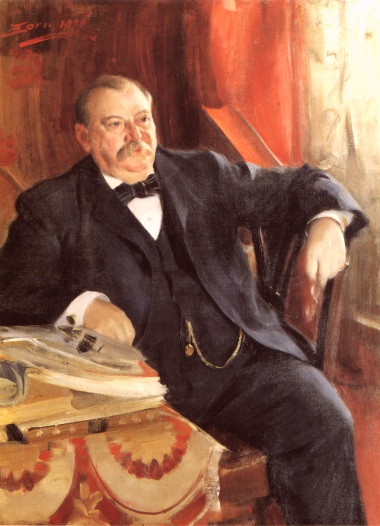Grover Cleveland's Secret Surgery, 1893
 |
| Painting of Cleveland by Anders Zorn, 1899 |
Grover Cleveland, as you may recall, was the 22nd and 24th President of the United States. He is the only President ever to have served two non-consecutive terms. When he began his second term of office in March 1893, he had a number of problems to deal with. Not the least of them was the state of the economy.
The Panic of 1893, a serious economic depression, began soon after Cleveland took office. The Panic was made worse by the shortage of gold that occurred largely as a result of the Sherman Silver Purchase Act. Cleveland believed that the only way to stem the depression was to repeal the Act, and he was certain that it would take his leadership to make it happen.
The last thing the country needed was a rumor of an ailing President. Consequently, when Cleveland discovered a small "rough patch" on the roof of his mouth in mid-June, he decided to keep it quiet.
He consulted privately with the White House doctor, Dr. O'Riley. O'Riley took a sample of what appeared to be a tumor on the left side of Cleveland's mouth and hard palate, and sent it to the army medical museum, not disclosing from whom he had obtained it. The sample was diagnosed as a probably non-malignant tumor.
 |
| Dr. Joseph Bryant |
The surgical team was made up of Cleveland's personal physician, Dr. Joseph Bryant, Dr. W. W. Keen of Philadelphia, three other doctors, and a dentist. Keen would, 24 years later, publish an article about the operation in the Saturday Evening Post.
In order to avoid any scars or other obvious signs of surgery, Bryant operated through the mouth, using a cheek retractor which Dr. Keen had brought from Paris in 1866. The two upper left bicuspids were removed, and then the left upper jaw nearly to the middle, along with a small portion of the soft palate. Nitrous oxide was administered for the early stages of the procedure, and ether for the later stages. Cleveland was a corpulent 56-year old, and the doctors were somewhat worried about the possibility of his suffering a stroke during the procedure. After the surgery, one-sixth of a grain of morphine was administered for pain.
.jpg) |
| The surgery was performed on the Oneida. |
Despite all the precautions, a rumor had leaked about a possible health problem for President Cleveland. At a press conference, reporters were told that the President has merely had a couple of teeth pulled. The reporters weren't quite sure whether they believed that or not, but after discussion between themselves, they all printed the same story. The President had had a toothache.
 |
| Dr. Keen later published the details in the Saturday Evening Post. |
Cleveland was well enough to return to Washington by August 7th -- the date scheduled for the special session of Congress. Cleveland was able to lead the Congress to a successful conclusion. The Sherman Act was repealed.
No comments:
Post a Comment